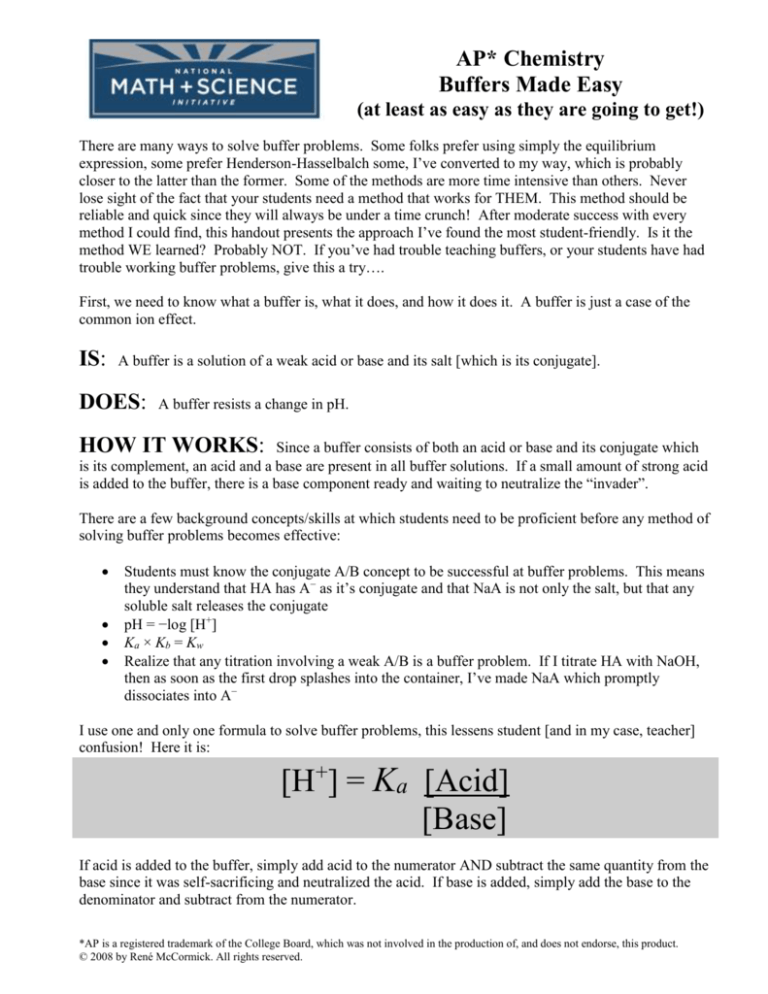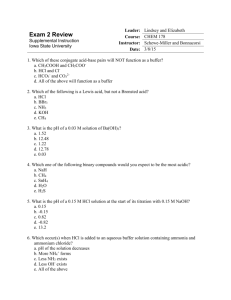
AP* Chemistry
Buffers Made Easy
(at least as easy as they are going to get!)
There are many ways to solve buffer problems. Some folks prefer using simply the equilibrium
expression, some prefer Henderson-Hasselbalch some, I’ve converted to my way, which is probably
closer to the latter than the former. Some of the methods are more time intensive than others. Never
lose sight of the fact that your students need a method that works for THEM. This method should be
reliable and quick since they will always be under a time crunch! After moderate success with every
method I could find, this handout presents the approach I’ve found the most student-friendly. Is it the
method WE learned? Probably NOT. If you’ve had trouble teaching buffers, or your students have had
trouble working buffer problems, give this a try….
First, we need to know what a buffer is, what it does, and how it does it. A buffer is just a case of the
common ion effect.
IS:
A buffer is a solution of a weak acid or base and its salt [which is its conjugate].
DOES:
A buffer resists a change in pH.
HOW IT WORKS:
Since a buffer consists of both an acid or base and its conjugate which
is its complement, an acid and a base are present in all buffer solutions. If a small amount of strong acid
is added to the buffer, there is a base component ready and waiting to neutralize the “invader”.
There are a few background concepts/skills at which students need to be proficient before any method of
solving buffer problems becomes effective:
Students must know the conjugate A/B concept to be successful at buffer problems. This means
they understand that HA has A− as it’s conjugate and that NaA is not only the salt, but that any
soluble salt releases the conjugate
pH = −log [H+]
Ka × Kb = Kw
Realize that any titration involving a weak A/B is a buffer problem. If I titrate HA with NaOH,
then as soon as the first drop splashes into the container, I’ve made NaA which promptly
dissociates into A−
I use one and only one formula to solve buffer problems, this lessens student [and in my case, teacher]
confusion! Here it is:
[H+] = Ka [Acid]
[Base]
If acid is added to the buffer, simply add acid to the numerator AND subtract the same quantity from the
base since it was self-sacrificing and neutralized the acid. If base is added, simply add the base to the
denominator and subtract from the numerator.
*AP is a registered trademark of the College Board, which was not involved in the production of, and does not endorse, this product.
© 2008 by René McCormick. All rights reserved.
When equal concentrations of Acid and Base are present [which occurs at the ½ equivalence point of a
titration] the ratio of acid to base equals ONE and therefore, the pH = pKa. IF you are asked to construct
a buffer of a specific pH and given a table of Ka’s, choose a Ka with an exponent close to the desired pH
and use equal concentrations of the acid and base.
Let’s try it! Here’s a common calculate the pH of a buffer before and after an “invader” is added. The
Ka of formic acid is 1.8 × 10−4
Exercise 1
Calculate the pH of 0.500 L of a buffer solution composed of 0.50 M formic acid and 0.70 M sodium
formate before and after adding 10.0 mL of 1.00 M HCl.
PREPARING BUFFER SOLUTIONS:
Use 0.10 M to 1.0 M solutions of reagents & choose an acid whose Ka is near the [H3O+] concentration
we want. The pKa should be as close to the pH desired as possible. Adjust the ratio of weak A/B and its
salt to fine tune the pH.
Exercise 2
Using an acetic acid\sodium acetate buffer solution, what ratio of acid to conjugate base will you need to
maintain the pH at 5.00? Explain how you would make up such a solution.
It is the relative # of moles of acid/CB or base/CA that is important since they are in the same solution
and share the same solution volume.
This allows companies to make concentrated versions of buffer and let the customer dilute--this will not
affect the # of moles present--just the dilution of those moles.
Buffers Made Easy
2
What if you’re given a Kb?
Exercise 3
A buffered solution contains 0.25M NH3 ( Kb = 1.8 × 10−5) and 0.40 M NH4Cl.
a) Calculate the pH of this solution.
b) Calculate the pH when 0.10 mol of gaseous HCl is added to 1.0 L of the buffered solution.
Exercise 4
A chemist needs a solution buffered at pH 4.30 and can choose from the following list of acids and their
soluble salt:
a. chloroacetic acid Ka = 1.35 × 10−3
b. propanoic acid
Ka = 1.3 × 10−5
c. benzoic acid
Ka = 6.4 × 10−5
d. hypochlorus acid Ka = 3.5 × 10−8
Calculate the ratio of A/B required for each system to yield a pH of 4.30. Which system works best?
Buffers Made Easy
3
ACID-BASE TITRATION CURVES
Only when the acid AND base are both strong is the pH at the equivalence point 7. Any other
conditions and you get to do a nasty equilibrium problem. It’s really a stoichiometry problem with a
limiting reactant. The “excess” is responsible for the pH
Weak acid + strong base eq. pt. > pH 7
Strong acid + weak base eq. pt. < pH 7
There is a distinction between the equivalence point and the end point. The end point is when the
indicator changes color. If you’ve made a careful choice, the equivalence point, when the number of
moles of acid = number of moles of base, will be achieved at the same time.
Exercise 5
For the titration of 50.0 mL of 0.200 M HNO3 with 0.100 M NaOH. Calculate the pH of the solution at
the following selected points of the titration:
a) NO NaOH has been added:
b) 10.0 mL of NaOH has been added:
c) 20.0 mL (total as opposed to additional) of NaOH has been added:
d) 50.0 mL (total) of NaOH has been added:
e) 100.0 mL (total) of NaOH has been added:
f) 200.0 mL (total) of NaOH has been added:
4 POINTS OF INTEREST ALONG A TITRATION CURVE for weak acids/bases:
Buffers Made Easy
4
1. the pH before the titration begins. Treat as usual, the base determines the pH.
2. the pH at the midpoint of the titrations (½ equivalence point)--[H3O]+ = [acid] Ka on the way
[base]
to the midpoint; once there, [H3O]+ = Ka and it follows that pH = pKa
3. the pH at the eq. pt.--find the pH of the salt, all the acid/base is now neutralized [water!]
4. the pH when base is added beyond the eq. pt.--[OH−] = moles of excess OH− from NaOH
total volume in Liters
Exercise 6
Hydrogen cyanide gas (HCN), a powerful respiratory inhibitor, is highly toxic. It is a very weak
acid (Ka = 6.2 × 10−10) when dissolved in water. If a 50.0 mL sample of 0.100 M HCN is titrated
with 0.100 M NaOH, calculate the pH of the solution
a) after 8.00 mL of 0.100 M NaOH has been added.
b) at the halfway point of the titration.
c) at the equivalence point of the titration.
Choose and indicator with a Ka near that of the acid you’re titrating AND whose color changes strongly at the
eq. pt.
Buffers Made Easy
5
Exercise 7
Use table 15.8 to decide which indicator would be best to use in the titration of ammonia with hydrochloric
acid.
Exercise 8
Bromthymol blue has a Ka value of 1.0 × 10−7, is yellow in its HIn form and blue in its In− form. Suppose we
put a few drops of this indicator in a strongly acidic solution. If the solution is then titrated with NaOH, at what
pH will the indicator color change first be visible?
Shall we try this with some retired AP questions?
6
Buffers Made Easy









